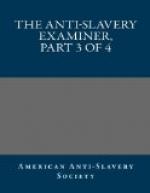“I am pained exceedingly, and nothing but my duty to God, to the oppressors, and to the poor down-trodden slaves, who go mourning all their days, could move me to say a word. I will state to you a few cases of the abuse of the slaves, but time would fail, if I had language to tell how many and great are the inflictions of slavery, even in its mildest form.
Benjamin James Harris, a wealthy tobacconist of Richmond, Virginia, whipped a slave girl fifteen years old to death. While he was whipping her, his wife heated a smoothing iron, put it on her body in various places, and burned her severely. The verdict of the coroner’s inquest was, “Died of excessive whipping.” He was tried in Richmond, and acquitted. I attended the trial. Some years after, this same Harris whipped another slave to death. The man had not done so much work as was required of him. After a number of protracted and violent scourgings, with short intervals between, the slave died under the lash. Harris was tried, and again acquitted, because none but blacks saw it done. The same man afterwards whipped another slave severely, for not doing work to please him. After repeated and severe floggings in quick succession, for the same cause, the slave, in despair of pleasing him, cut off his own hand. Harris soon after became a bankrupt, went to New Orleans to recruit his finances, failed, removed to Kentucky, became a maniac, and died.
A captain in the United States’ Navy, who married a daughter of the collector of the port of Richmond, and resided there, became offended with his negro boy, took him into the meat house, put him upon a stool, crossed his hands before him, tied a rope to them, threw it over a joist in the building, drew the boy up so that he could just stand on the stool with his toes, and kept him in that position, flogging him severely at intervals, until the boy became so exhausted that he reeled off the stool, and swung by his hands until he died. The master was tried and acquitted.
In Goochland County, Virginia, an overseer tied a slave to a tree, flogged him again and again with great severity, then piled brush around him, set it on fire, and burned him to death. The overseer was tried and imprisoned. The whole transaction may be found on the records of the court.
In traveling, one day, from Petersburg to Richmond, Virginia, I heard cries of distress at a distance, on the road. I rode up, and found two white men, beating a slave. One of them had hold of a rope, which was passed under the bottom of a fence; the other end was fastened around the neck of the slave, who was thrown flat on the ground, on his face, with his back bared. The other was beating him furiously with a large hickory.
A slaveholder in Henrico County, Virginia, had a slave who used frequently to work for my father. One morning he came into the field with his back completely cut up, and mangled from his head to his heels. The man was so stiff and sore he could scarcely walk. This same person got offended with another of his slaves, knocked him down, and struck out one of his eyes with a maul. The eyes of several of his slaves were injured by similar violence.




